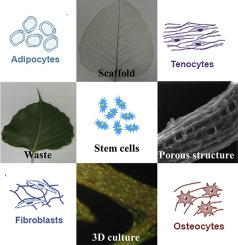Sustainable Chemistry and Pharmacy ( IF 6 ) Pub Date : 2020-09-16 , DOI: 10.1016/j.scp.2020.100321 Vaiyapuri Subbarayan Periasamy , Jegan Athinarayanan , Ali A. Alshatwi

|
Large quantities of natural fibers are available in the plant biomass that can be utilized for various purposes including three dimensional cell culture and tissue engineering due to their biocompatibility, ecofriendly, easy availability and cost effective. Especially, leaf skeletons (venation architecture) have a complex hierarchical architecture with novel properties. In this present invention describes about developing three dimensional scaffold from plant leaf skeletons for three dimensional cell culture. Plant leaf skeleton is prepared by simple and rapid method which using sodium hydroxide pretreatment under pressurized condition at 120°C for 1 h. The prepared plant skeleton has microporous surface topography. Also, the plant leaf skeleton is mainly composed by hemicellulose, cellulose and lignin. The microscopic analysis clearly indicates that human mesenchymal stem cells (hMSCs) attached and proliferated on plant leaf skeleton. Interestingly, cell density of hMSCs is increased on plant leaf skeleton by incubation time-dependent manner. Our study confirmed that sodium hydroxide via surface modified Ficus religiosa leaf skeleton enhances the attachment and proliferation of the human mesenchymal stem cells because of their biocompatibility and porous nature. The chemical nature and venation architecture of leaf skeleton has facilitated nutrient and oxygen absorption to promote cell-cell interaction, long term cell culture, and possible scope for induction of cell differentiation. Thus, leaf venation architecture can be applied as three dimensional (3D) cell-culture platform for multi-layer cell culture, cell-based assay model, high-throughput drug screening, cell-replacement therapy, wound healing and substitute for skin. Moreover, this scaffold could also be well-suited to co-culture screening strategies and stem cell differentiation for tissue engineering. Our present invention highlighted agro-wastes as precursor for novel scaffold materials to construct the 3D cell culture platform.
中文翻译:

基于生物灵感的植物叶片骨架的三维支架,用于三维细胞培养
植物生物质中有大量天然纤维,由于它们的生物相容性,生态友好性,易得性和成本效益,可用于多种用途,包括三维细胞培养和组织工程。尤其是,叶片骨架(通风结构)具有复杂的具有新颖属性的层次结构。在本发明中描述了关于从植物叶片骨架开发三维支架用于三维细胞培养的方法。植物叶片骨架是通过简单,快速的方法制备的,该方法使用氢氧化钠在120°C的加压条件下预处理1小时。制备的植物骨架具有微孔表面形貌。另外,植物叶片骨架主要由半纤维素,纤维素和木质素组成。显微镜分析清楚地表明,人间充质干细胞(hMSCs)附着并在植物叶片骨架上增殖。有趣的是,hMSCs的细胞密度通过温育时间依赖性的方式在植物叶片骨架上增加。我们的研究证实氢氧化钠可以通过表面改性菩提树叶片骨架由于其生物相容性和多孔性而增强了人间充质干细胞的附着和增殖。叶骨架的化学性质和脉络结构促进了养分和氧气的吸收,从而促进了细胞与细胞之间的相互作用,长期的细胞培养以及诱导细胞分化的可能范围。因此,叶脉结构可以用作多层细胞培养,基于细胞的测定模型,高通量药物筛选,细胞置换疗法,伤口愈合和皮肤替代的三维(3D)细胞培养平台。此外,该支架也可能非常适合用于组织工程的共培养筛选策略和干细胞分化。

























 京公网安备 11010802027423号
京公网安备 11010802027423号